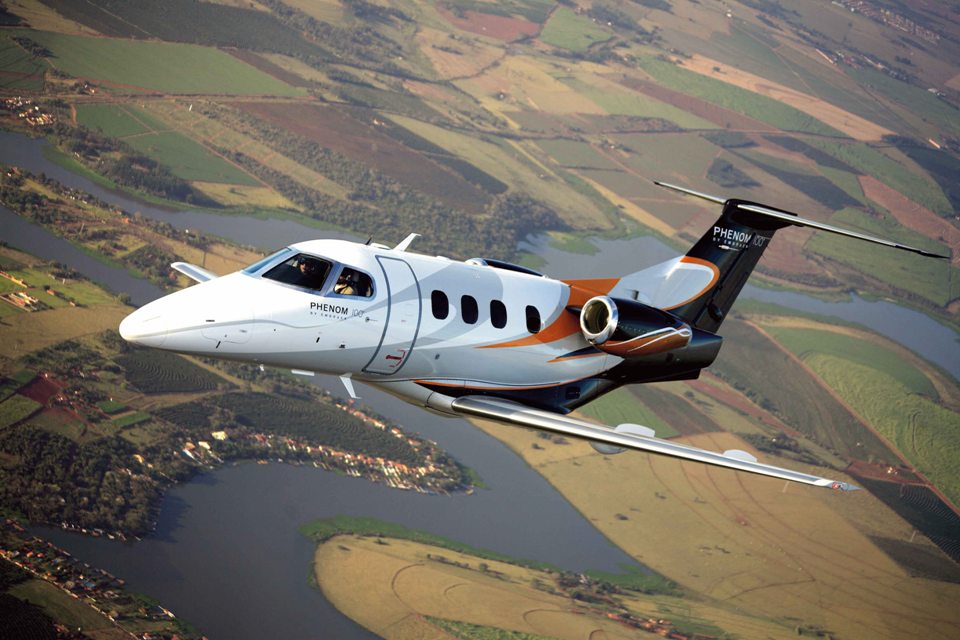

The latest version of a market-leading entry-level jet offers important improvements.
It’s no wonder that Embraer has delivered more than 300 of its Phenom 100 entry-level jets since 2009. Fast and spacious for its class—with a top speed of 390 knots and now room for up to eight occupants—the aircraft resonates with smaller companies, charter operators and individual owners.
Compared with another entry-level jet, the Cessna Citation Mustang, the 100 cruises 50 knots faster and weighs 1,000 pounds more (at maximum takeoff weight). At 1,178 nautical miles, it has about the same range. It holds slightly more luggage (71 cubic feet) and has a larger, more versatile cabin. It can be configured to seat four or six in the cabin, can add an extra passenger when flown single-pilot, and can fit one more on the belted lavatory seat. The Phenom also has a true aft lavatory with an optional solid door.
The 100’s cabin also features enclosed, pleated window shades; Ultraleather upper sidewalls; carpeted or wood floors; laminate, gloss or veneer cabinet finishes; and carpeted or fabric lower sidewalls. The seats are unusual as well. The headrests are offset from center slightly, designed in a way that provides support when a passenger naturally tilts his head toward the sidewall while napping or looking out the window. The seat cushions are 18 inches wide, have longitudinal tracking, recline from eight to 20 degrees and have integral three-point seatbelts and inboard armrests. For an aircraft this size, they are very comfortable.
The 100E provides updated avionics and Gogo Biz Internet options. It also addresses problems with the 100’s brake-by-wire system and errant brake-warning CAS (crew alerting system) messages, which led to several runway-overrun accidents and runway incidents such as blown tires. The absence of thrust reversers and perceived deficiencies in the aircraft’s “lift-dump” aerodynamic braking were sources of nervousness for pilots, particularly on runways contaminated with snow and ice. Embraer immediately sought to remedy the brake-by-wire problems with a software fix and by redesigning the brake-control unit and altering the pedal position and feel to bring it in line with the feedback pilots get with conventional mechanical/hydraulic brakes.
To give the aircraft slower descents and surer footing during landings, the 100E comes with multifunction wing spoilers. Officially, Embraer says they make no difference in required stopping distance—which is published as 2,722 feet, the same as for the 100—but they do to varying degrees.
Juarez Santos, who flies a 100E for a Brazilian food company, says that the spoilers enhance maneuverability and improve braking effectiveness on the ground while enabling more rapid descents. “They’ve raised the aircraft’s versatility,” he comments. Santos has more than four years and 1,000 hours of flight time in Phenom 100s. He flies about 25 hours a month and his missions are often in Brazil’s interior, where terrain and weather collide to produce challenging visibility and heavy precipitation.
While the original 100’s interior drew praise, some early customers complained about seat comfort and the noise level of the two-zone environmental-control system fans. There were also limited choices regarding interior fabrics and colors.
The fans were hushed some time ago, and on the 100E Embraer is offering premium slide, swivel and recline single executive seats, similar to those aboard the larger Phenom 300, as an extra-cost option. A significant number of new fabric and color combinations are available on the 100E at no additional charge. Wood veneer is standard and customers can choose from a variety of enhanced cabinetry offerings, including a new galley cabinet (in place of the onboard forward closet or side-facing passenger seat). Compared with its progenitor, the 100E is substantially improved. It should sell well for years to come.
